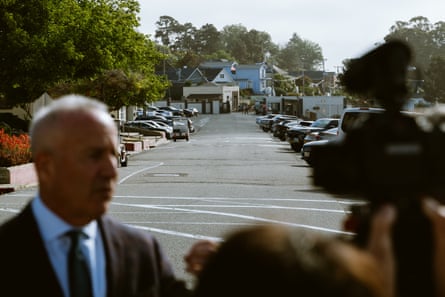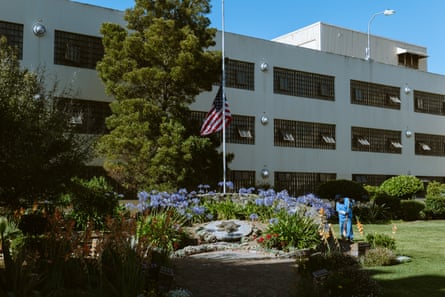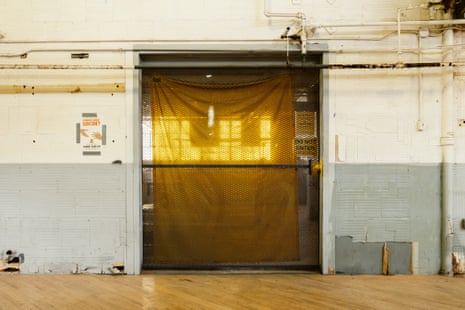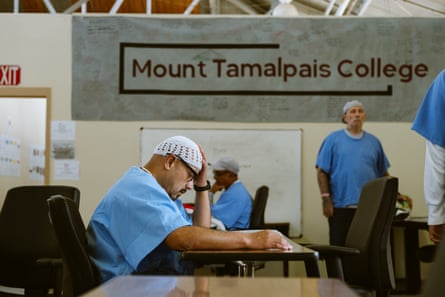On the recreation yard of San Quentin prison on a recent morning, dozens of residents were jogging around an open track, playing basketball and lounging on grass and picnic tables. Lt Guim’Mara Berry was leading a media tour of California’s oldest prison, touting its acclaimed running club and a recent pickleball game between staff and residents.
Officials had brought in a group of reporters to promote Governor Gavin Newsom’s plan to “completely reimagine what prison means” by transforming the complex into a “rehabilitation center” inspired by prisons in Norway, where officers act more like social workers.
But one scene on the yard laid bare the challenges ahead for San Quentin, a storied institution full of contradictions. A cry from above drew our attention to small outdoor cages on a roof nearby that were not part of the tour. There, men sentenced to death get exercise time in individual “walk-alone” metal enclosures: “We want to be free, too!” a man yelled.
It was a reminder that while the prison has been a national leader in arts, athletics, education and media programming and is now embarking on large-scale reforms, some of its residents remain incarcerated in some of the harshest prison living conditions in America. Many of them are serving decades-long or life sentences and have no access to existing programs. And those on death row won’t see the implementation of the new reforms – Newsom will be shuttering the unit, but the more than 500 men inside will be shipped off to other institutions.

As the prison continues its transformation, officials are hopeful and some guards have shown cautious optimism. On the minds of many incarcerated people is who will be left behind by the reforms, and whether a system so deeply rooted in punishment can actually transform its culture.
“I’m excited and hoping we can expand the opportunities here,” said Tony Tafoya, 34, who has been at San Quentin for four years. Away from the news cameras, he added: “The biggest hurdle is going to be staff buy-in. It feels to me the mindset is so ingrained from day one at the academy that we are enemy No 1, and they’re going to war. For them to even think that’s not their job any more, that’d be a 180 change.”
‘We have to treat them like citizens’
San Quentin, established in 1852 just after California became a state, sits on a peninsula shore a short drive north of San Francisco. Steps away from the barbed-wire fences, watchtowers and tall walls is the vast, glistening water of the bay.
Over the years, San Quentin became one of the most notorious prisons in the US, home to the largest death row in the country and the site of 500 executions. In recent decades, the prison, like the rest of the California department of corrections and rehabilitation (CDCR), has grappled with violence, officer misconduct, severe overcrowding and routine medical neglect that at one point was causing more than one preventable death a week across CDCR.
Today, there are nearly 4,000 people imprisoned at San Quentin, 120% over capacity. In some units, two people share roughly 4ft by 8-9ft cells with bunks and a toilet, akin to living in a small bathroom with a roommate.

After leading us through three security checkpoints, with rows of heavy metal gates slamming shut behind us, Darrell Steinberg, the mayor of Sacramento and lead adviser for Newsom’s San Quentin transformation advisory council, said the state was pursuing a fundamental change in the way officers function: “They are not currently trained throughout the system on rehabilitation.”
“I’ve spent my whole career with the north star being safety and security,” said Ron Broomfield, the San Quentin warden. “But we’ve started to realize the north star is really public safety, and to accomplish public safety, we have to prepare these citizens for re-entry into society. We’re not going to do that by institutionalizing them. We’re going to do that by treating them like citizens of our state, preparing them with opportunities.”
To do that, San Quentin is building on some of its existing programming. We went to the media center where incarcerated people produce award-winning podcasts, films and the San Quentin newspaper. “This is a space unlike any prison – it’s like a real workplace environment and newsroom, one of the only newsrooms left in the country, from what I’m hearing,” joked Steve Brooks, the 51-year-old editor-in-chief of the paper, incarcerated since 1996. “As you can see, we don’t have any officers around with guns held over us.”
At each stop, we met residents with impressive achievements, including college students and people who’d learned coding, who had ambitions to launch businesses upon release. But the programs only serve a fraction of residents, with many stuck on long waiting lists.

The officials also took us to an empty 81,000-square-foot warehouse, once a furniture factory. Standing under flickering fluorescent lights, Broomfield said CDCR would be tearing it down and building new facilities meant to resemble a college campus. Lawmakers have appropriated $360m for the change, a decision decried by advocacy groups who’ve argued funding new prison construction is an ineffective strategy to address the state’s mass incarceration crisis.
To be successful, the new San Quentin will need to have fewer residents, said Steinberg, who added that the advisory council did not yet have a target population size.
Skepticism and fears
Arthur Jackson, 51, who has been at more than a dozen prisons, and inside San Quentin since 2016, was skeptical of the plan: “I’ve been incarcerated for 30 years, and I’ve seen these big grandiose announcements come and go,” he said. “I am hopeful that for the first time in history, the governor did admit that this is a toxic environment and it’s harming people. That feels new. But if they’re saying we’ll build a new building and that’ll change our culture, and solve our problems, that’s an old idea … There’s no way you can make this into some humane place.”
He pointed out that many in San Quentin only got to shower three times a week. Last month, roughly 1,700 residents went without running water after a pipe failure. And he said he wished the prison would enforce rules on the books so staff would held accountable if they mistreated or disrespected residents. Ryan Pagan, 35, noted how they could still struggle to get quality time with loved ones: “They still treat visiting as a privilege, rather than a right – as something they can take away from you.”

Ricardo Romero, 46, incarcerated for 23 years, said he had noticed a positive shift since Newsom announced his plan in March: “For years, it’s been, ‘I’m a correctional officer, you’re an inmate,’ and that’s it. Now they’re trying to create an atmosphere where I can go to an officer, talk to him like a human, and get a response. They’re more approachable; they call you by your name.”
By first names? I asked. “Not yet,” he laughed.
Romero and Jackson are among the 35,000 people across CDCR serving life sentences, meaning they are indefinitely imprisoned unless they’re resentenced or parole commissioners and the governor decide to free them. With the transformation project focused on re-entry, “lifers” have grown afraid that they will be shipped off to rural prisons with little programming while the new San Quentin serves those with scheduled dates to come home. Romero’s last appeal for freedom was denied in January.
“I’ve put in a lot of hard work and the last thing I’d want is to be taken out of an atmosphere that is specifically for rehabilitation.”

Steinberg said that some lifers would remain at San Quentin, some acting as mentors to those with shorter sentences, but it’s unclear how many will be displaced.
The Scandinavian experiments
San Quentin would be the largest American prison to adopt a Scandinavian model, but not the first. Last year, Pennsylvania officials launched a “Little Scandinavia” unit in one of its prisons. It houses 64 people and has outdoor green space, plants throughout, private rooms, a communal kitchen, a grocery program with fresh food, and life-skills programs. The idea is to help people return home as “good neighbors”.
Staff had to adopt a new fraternization policy for Little Scandinavia, since, as is the case for many US prisons, the rules generally prohibited officers from talking to residents for any extended period, said Jordan M Hyatt, a Drexel University professor co-leading a research project assessing the new unit: “The Scandinavian model turns on that, so the officers had to propose new parameters that met the security requirements but allowed them to have more meaningful engagement.” One early measure of success, he said, was that the dire warnings of critics had not come to pass – there had been no assaults on staff.
It’s a proof of concept, even if small-scale, said Synøve N Andersen from the University of Oslo and the other co-lead researcher: “It is possible to change what a prison unit looks like, how people do their jobs and how people experience that space.”

When done right, the Norway model can also create a better environment for staff, said Tom Eberhardt, a longtime officer and manager with the Norwegian correctional service, who now works with a University of California group that advises US prisons. When he’s asked US guards what they consider a good work day, they’ve often responded: “‘When I get home alive,’” he said. “If you’re working in a prison for 30 years and that’s what you care about, that will be a really stressful 30 years.”
Prison officials in several other states have pursued reforms, with varying success. After visiting Norway’s facilities, Leann Bertsch, the former head of the prison system in North Dakota, a deep-red state, said it was clear to her that the inhumanity of US prison environments was harming incarcerated people. She tried to establish more normal activities, such as music and art, and redo training so staff treated residents with respect. But, she said, “I underestimated that certain people came to work in corrections because they really loved being in a place of authority over another human being.”

Joseph Havard, a San Quentin officer for eight years, has been working in the prison’s new “earned living unit”, which has fewer restrictions, is focused on rehabilitative programming and serves residents without disciplinary violations. “Giving them that aspect of independence back a little bit has really had a mental shift for a lot of these inmates and they’re working really hard,” he said. “It just makes for a really easy day.” He said it was rewarding to see residents make progress and to develop a rapport with them. “I wouldn’t say ‘relationship’ because that’s still a scary word to officers,” he said.
Havard acknowledged some longtime officers might be skeptical: “They come from a different time, when every inmate on the yard had a knife on them,” he said. “There’s no way they can see this actually happening, because how many times in the past have we tried to do stuff like this and it fails?” The governor’s plan would be successful if the new San Quentin served people dedicated to coming home, he added.
Havard also said the hardest part of his career had been working in units where people have no hope of ever leaving – who, in his view, “have nothing to lose”.

‘I hope someday they reach me’
As our tour started to wrap up, I ran into Jessie Milo, 43, who said he’d spent his two decades in prison learning how to cultivate optimism, against all odds.
“I had to believe in the lie of hope to get through and not take my own life and exist in here. It’s a hard concept to grasp as a kid that the rest of your life has no value,” he said, referring to his roughly 170-year sentence at age 22 for attempted murder. He now makes comics for the San Quentin newspaper and is an ambassador for the People in Blue, a group advocating that incarcerated views be incorporated in the transformation process.
“Though I don’t have a release date today, I get to be here on the ground floor and help others change,” he said, noting that under his current sentence, he would never walk free.
A CDCR representative told me the tour was ending but said Milo could walk with me to finish our conversation. As we headed toward the exit, he said: “What happens within these walls won’t change my sentence, but they have given us a lot of hope. And for people like me sentenced to die here, we just have to hope that someday they do reach us.”
